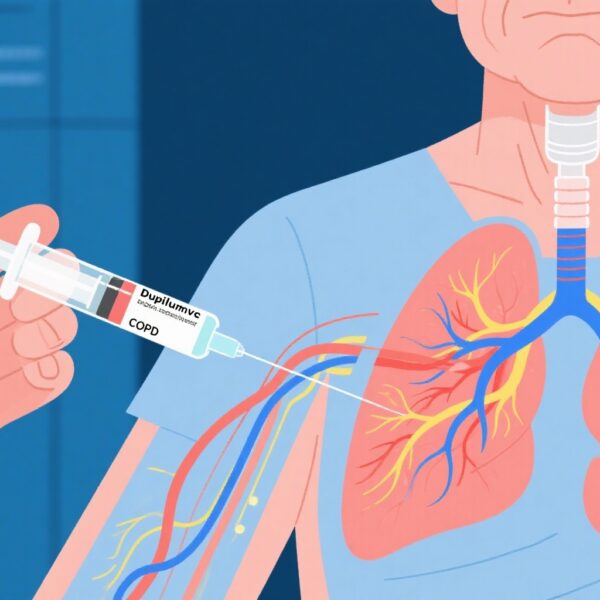Highlight
1. Low-dose sustained-release morphine (20 mg/day) does not alter sleep efficiency or sleep-disordered breathing event frequency in patients with chronic obstructive pulmonary disease (COPD) experiencing breathlessness.
2. Morphine reduces breathing frequency but leads to a significant increase in nocturnal hypoventilation evidenced by higher transcutaneous CO2 and lower oxygen saturations.
3. No improvement in subjective breathlessness or impairment in next-day simulated driving alertness were observed.
4. Adverse events, most commonly nausea, were more frequent with morphine, underscoring safety concerns.
Study Background and Disease Burden
Chronic breathlessness profoundly affects patients with COPD, impairing quality of life and daily functioning. Opioids such as low-dose morphine are increasingly prescribed off-label to relieve refractory breathlessness. Clinical reports and subjective assessments suggest morphine may modulate breathlessness partially through improvements in sleep quality or subtle sleep-related mechanisms. However, COPD patients are vulnerable to respiratory depression and hypoventilation triggered by opioids, especially during sleep, which could exacerbate hypoxemia and hypercapnia. Despite these concerns, objective data elucidating the effects of low-dose morphine on sleep physiology and safety in COPD are scarce. This gap has hindered clear guidance regarding the clinical use of opioids for breathlessness in this population.
Study Design
This investigation was a randomized, double-anonymized, crossover trial conducted in 19 adults with COPD suffering from chronic breathlessness, including seven women. Participants received either sustained-release morphine at 20 mg daily or placebo for three days, with a washout before crossover to the alternate treatment. The steady-state dosing period aimed to reflect routine clinical morphine administration for symptom control. The primary endpoint was sleep efficiency, measured via in-laboratory nocturnal polysomnography (PSG). Secondary and exploratory endpoints encompassed sleep-disordered breathing event frequency (apneas/hypopneas), oxygen saturation nadirs and means, transcutaneous CO2 levels, blood biomarkers, relationships between sleep parameters and daytime breathlessness, respiratory responses to external resistive loads, and objective cognitive performance assessed by next-day driving simulation. Pharmacokinetic and physiological parameters were evaluated pre- and post-PSG. The study sought to leverage rigorous quantification of respiratory and sleep dynamics to clarify potential benefits and risks of low-dose morphine in this clinical context.
Key Findings
Sleep Efficiency: The primary outcome—sleep efficiency—showed no significant difference between morphine and placebo arms (morphine: 67 ± 19% versus placebo: 66 ± 17%; P = .89). This indicates that low-dose morphine does not enhance or impair the overall proportion of sleep time spent asleep in COPD patients with breathlessness.
Sleep-Disordered Breathing and Respiratory Patterns: Morphine administration did not alter the frequency of sleep-disordered breathing events per hour, suggesting no increased risk of obstructive or central apnea-hypopnea syndrome under this dosage.
However, morphine significantly reduced the overall breathing frequency during sleep. Moreover, mean overnight oxygen saturation dropped by approximately 2% (95% CI, -2.8% to -1.2%) with morphine, and the nadir oxygen saturation decreased by 5% (95% CI, -8% to -1%). Concurrently, mean transcutaneous CO2 increased by 3.3 mm Hg (95% CI, 1.6-5.1 mm Hg), indicating hypoventilation.
Hypoventilation Risk: The number of participants meeting the American Academy of Sleep Medicine criteria for nocturnal hypoventilation doubled on morphine (42%) compared to placebo (21%), a statistically significant difference (P = .02). These findings highlight a potentially harmful respiratory consequence of morphine during sleep in COPD.
Breathlessness and Next-Day Alertness: Morphine did not systematically reduce subjective breathlessness nor adversely affect next-day driving simulator performance, suggesting limited symptomatic or cognitive benefit under study conditions.
Adverse Events: The morphine arm experienced a higher incidence of adverse events, primarily nausea, underscoring tolerability challenges even with low-dose opioid therapy.
Expert Commentary
This study rigorously addresses an important clinical conundrum: how to balance breathlessness relief against respiratory risks with opioid use in COPD. The objective polysomnography data contribute novel insights that low-dose morphine neither improves sleep architecture nor reduces respiratory events, yet poses a clear hypoventilation risk. This respiratory depression during sleep could exacerbate chronic CO2 retention and hypoxemia, raising safety concerns that must temper enthusiasm for opioid use in this population.
The lack of improvement in subjective breathlessness contrasts with some previous uncontrolled reports, suggesting that morphine’s symptomatic benefit may be less robust or heterogeneous. Notably, next-day alertness and psychomotor function were preserved, which partially alleviates concerns regarding residual sedation at the studied dose.
Limitations include the small sample size and short treatment duration, which restrict conclusions on long-term safety and efficacy. The crossover design is a methodological strength, minimizing inter-individual variability. Future studies should explore patient subgroups, dose-response relationships, and integration of multimodal breathlessness management strategies.
Clinicians must carefully weigh these findings against clinical need, considering alternative therapies and vigilant monitoring when prescribing opioids in COPD.
Conclusion
In summary, this randomized crossover trial demonstrates that sustained-release low-dose morphine does not alter sleep efficiency or sleep-disordered breathing frequency in patients with COPD but significantly increases nocturnal hypoventilation and reduces oxygen saturation. There was no observed symptomatic breathlessness improvement or impairment in daytime alertness, while adverse effects such as nausea were more frequent. These results call for cautious prescription of opioids for chronic breathlessness in COPD, emphasizing the need to balance potential symptomatic relief against respiratory safety risks during sleep. Further larger trials and mechanistic studies are warranted to optimize management strategies for this challenging symptom.
References
Altree TJ, Pinczel AJ, Toson B, Loffler KA, Hudson AL, Zeng J, Proctor S, Naik G, Mukherjee S, Catcheside P, Somogyi A, Currow DC, Eckert DJ. The Effects of Low-Dose Morphine on Sleep and Breathlessness in COPD: A Randomized Trial. Chest. 2025 Jun;167(6):1578-1590. doi:10.1016/j.chest.2024.11.040. Epub 2024 Dec 13. PMID: 39675518.
Additional relevant literature:
Currow DC, McDonald C, Oaten S, et al. Once-daily opioids for chronic breathlessness: a dose increment and pharmacovigilance study. Eur Respir J. 2013;42(6):1574-1583.
Ekström M, Bajwah S, Bland JM, et al. Safety of benzodiazepines and opioids in very severe respiratory disease: national prospective study. BMJ. 2014;348:g445.
American Academy of Sleep Medicine. International Classification of Sleep Disorders, 3rd ed. Darien, IL: AASM; 2014.



